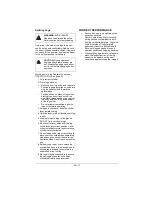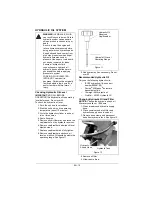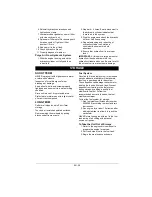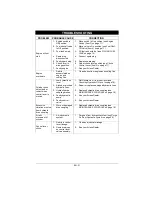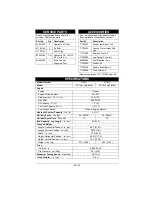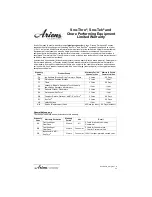
EN - 16
3. Move rear stabilizer to transport position
and lock in place (see
4. Attach log splitter hitch to tow vehicle
with class 1 or higher receiver and 2-in.
ball. Adjust hitch coupler to ensure lock
lever fully locks onto ball with no excess
movement. Install a locking pin or lock
through the lock lever.
5. Move front stand to transport position
and lock in place (see
NOTICE:
Tow vehicles with low ball heights
will require the stand to be stored before
attaching the hitch coupler to the ball.
6. Cross unit safety chains under the
coupler and attach to tow vehicle.
Check Tire Pressure
See
on page 22 for tire
pressure.
OPERATION
Work Site
Set up log splitter in an area that provides:
•
a dry level surface.
•
good footing that is free of debris or
other tripping hazards.
•
sufficient clearance for engine exhaust
to not blow directly on combustible
material.
Disconnect the log splitter from the tow
vehicle before operating. If splitting logs in the
horizontal position, move rear stabilizer to
work position (see
on page 14). Chock the wheels to prevent
movement during operation.
Warm Up Unit
When using the unit in temperatures of 68°
F (20° C) or lower, the hydraulic system
should be cycled before splitting logs. This
allows the cool hydraulic oil in the cylinder to
be circulated before placing a load on the
hydraulic system.
1. Start the engine and allow it warm up
2. Cycle the cylinder through three or four
full extension/retraction cycles.
3. Proceed with splitting logs.
IMPORTANT:
Always split logs with engine
set at Fast position.
CAUTION:
Avoid damage or
injury! Use maximum caution
when towing log splitter:
•
DO NOT exceed 45 mph
(72.4 kph).
•
Obey all applicable local,
state and federal laws
regarding towing.
•
DO NOT carry passengers,
cargo or logs on the towed
unit.
•
Allow for the extra length of
the unit when turning,
parking, crossing
intersections and in all driving
situations.
•
Ensure that stabilizers are
locked in the transport
position and that the beam is
locked before moving unit.
•
Drive slowly and take extra
caution over rough terrain.
CAUTION:
Avoid injury!
Explosive separation of tire and
rim parts is possible when they
are serviced incorrectly:
•
Do not attempt to mount a
tire without the proper
equipment and experience to
perform the job.
•
Do not inflate the tires above
the recommended pressure.
•
Do not weld or heat a wheel
and tire assembly. Heat can
cause an increase in air
pressure resulting in an
explosion. Welding can
structurally weaken or
deform the wheel.
•
Do not stand in front or over
the tire assembly when
inflating. Use a clip-on chuck
and extension hose long
enough to allow you to stand
to one side.
















